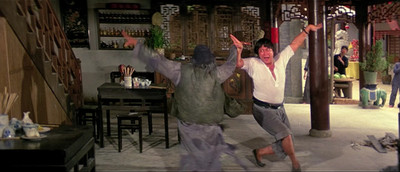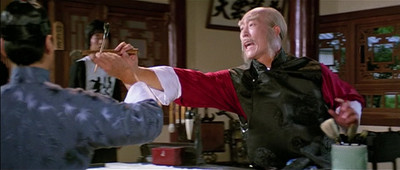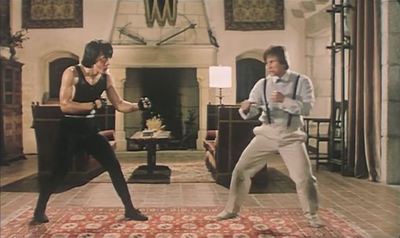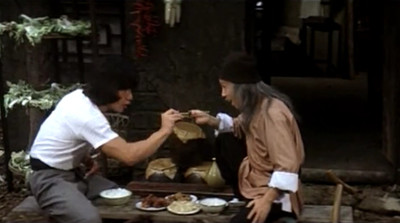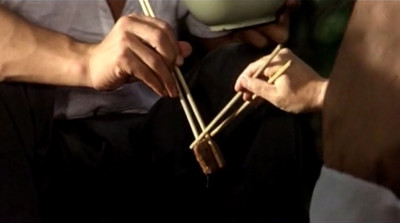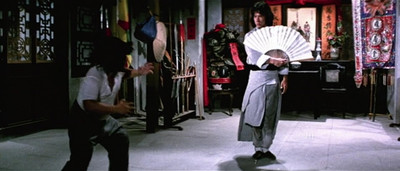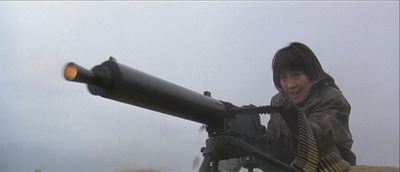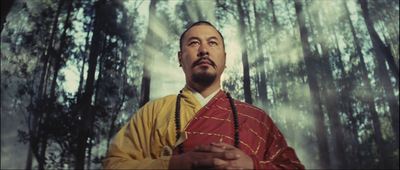In his review of Crouching Tiger, Hidden Dragon, Roger Ebert compared martial arts movies to musicals:
Fight scenes in a martial arts movie are like song-and-dance numbers in a musical: After a certain amount of dialogue, you’re ready for one.
It’s an observation that he’d made before, but it’s one that strikes a resonant chord with me. I mean, I’m not a huge fan of musicals, but I sure do enjoy martial arts movies. Yet the mechanisms and structure of both are almost the same. Is there really that much of a difference between Fred Astaire and Ginger Rogers and Jackie Chan and Sammo Hung? Apparently not! As Ebert notes:
The best martial arts movies have nothing to do with fighting and everything to do with personal excellence. Their heroes transcend space, gravity, the limitations of the body and the fears of the mind. In a fight scene in a Western movie, it is assumed the fighters hate each other. In a martial arts movie, it’s more as if the fighters are joining in a celebration of their powers.
Indeed, and while that might not completely hold true in all cases, it is something that sorta feels right anyway.
Early this year, I noticed that Amazon Prime streaming had made a whole slew of classic martial arts movies available, so I resolved to start exploring. As I made my way through what was available, I did start to stray further afield (even sometimes resorting to, gasp, physical media to see some of these). What follows is a pretty wide broad-section of the field, by no means comprehensive, but a decent place to start if anyone is curious. For the sake of honesty, I wasn’t initially taking notes, so my recollections on some of these are a little sparse, but I figured I’d include everything I’ve watched this year. For posterity! This was a generally fun exercise and I expect my explorations of the genre to continue, but I figured it was time to finally start documenting what I’ve watched. Let’s get to it:
The Prodigal Son (1981) – Directed by Sammo Hung, this one tones down the humor a bit, but the very premise is somewhat amusing. Yuen Biao stars as Chang, a wealthy heir that believes himself to be a kung fu master. However, it turns out that his father has been paying people to lose to him. Embarrassed, Chang joins a traveling circus in the hopes of learning from the master of that troupe. Hung plays a small part as one of Chang’s instructors, but is mostly behind the camera, with Yuen Biao and Ching-Ying Lam (you will see some of these names often below). This is a prime example of Wing Chun style, a form of close quarters martial arts involving grappling and striking. Action Highlight: The final one-on-one fight is pretty great and represents a culmination of the action sequences, which start with light sparring and gradually become more and more serious and brutal as the film progresses, until you reach the finale. Clear, fluid, well choreographed stuff all throughout, and there’s a good balance of action to plot. ***
Eastern Condors – This is a really unusual one about a mission to Vietnam to destroy a munitions depot left behind by Americans before anyone can put the weapons to nefarious use. There’s actually very little martial arts in the movie, and what is there feels a bit out of place in a Vietnam narrative. I watched it due to Sammo Hung’s involvement and he is technically the lead, but it’s more of an ensemble piece (Yuen Biao shows up again). As Vietnam movies go, this doesn’t quite stand up to the classics and isn’t as fun as the more ridiculous 80s offerings. You’d be better off watching the movies that inspired this, like The Dirty Dozen, though I gather I’m an outlier in disliking this movie (it seems popular). Action Highlight: I guess the end at the munitions dump? I was not enamored with the action here. *
Magnificent Butcher (1979) – Another Sammo Hung vehicle, he plays “Butcher” Wing in this one, a student of legendary martial arts master Wong Fei-hung (a mainstay character in HK cinema). His newly wed brother comes to town, but the bride is promptly kidnapped by a student of a local rival master. He must team up with his brother and local a local drunken master to try and save her. Before I get to the action, which is amazing, I have to ding the plot here. Now most of these movies don’t have a great plot, but the kidnapped wife trope is executed poorly here. Spoiler: she is murdered, leading to a revenge killing of the kidnapper. But the kidnapper’s master doesn’t know about all this, and vows revenge of Hung’s character. The final battle sees Hung defeating the rival master, but it all feels a little wrong. That being said, the action in this film is phenomenal.
Directed by famed choreographer Woo-Ping Yuen, one would expect nothing less. Clear, fluid, intricate fights all throughout, and Sammo Hung is a spectacular performer. If you don’t know Sammo, he’s, well, on the overweight side of things. And yet he manages to be among the most nimble acrobats I’ve ever seen in one of these movies. The other performers hold their own, of course (look, another Yuen Biao appearance), aided as they are by Woo-Ping Yuen’s choreography. If you’re willing to overlook the unpleasantness in the plot, this is a spectacular action film.
Action Highlight: The calligraphy battle is marvelous and a standout from all the movies in this post, but the final showdown with Sammo Hung is also worth noting. ***
Warriors Two (1978) – Another Sammo Hung directed film, this is also a classic showcase for the Wing Chun style starring Casanova Wong (the famed “Human Tornado”). Wong plays a humble cashier who stumbles on a plot to assassinate the local mayor. Action Highlight: The last half hour of the film is almost non-stop action, with the highlight being Wong and Hung’s two on two battle with the villains of the piece, including a weird “juggling” maneuver… **1/2
Wheels on Meals (1984) – A famous team-up of Jackie Chan, Yuen Biao, and Sammo Hung, it’s hard to beat that trio. Chan and Biao play cousins and business partners (owning a futuristic food truck, decades before such things were trendy), and Hung plays an inexplicably Jheri curled private detective. They all get wrapped up in some sort of weird crime gambit involving a young woman. Whatever, it’s all just an excuse to get to the fights, which are great, varied, and numerous. This is one of the many movies in which Jackie Chan, clearly a susperstar, manages to generously share the screen with multiple costars (who, frankly, are also superstars within this genre).
Action Highlight: Jackie Chan’s infamous duel with Benny “The Jet” Urquidez towards the end of the film is astounding and features one of the coolest bits: Benny does a spinning kick so fast that he generates enough airflow to extinguish some candles on set. It was apparently an accident, but they obviously left it in the film because it’s so cool (and another example of Chan’s willingness to share the spotlight). ***
The Fearless Hyena (1979) – Jackie Chan’s directorial debut about dueling martial arts schools and old enemies finding out about one of the masters because, yeah, the usual martial arts plot here. Revenge is involved. But the fights are great, and Chan goes through some amusing costuming.
Action Highlight: Lots to choose from, but the really memorable bit is one of the training sequences where Chan’s new master prompts him to eat piece of meat sitting in front of him. What follows is a legit duel fought with chopsticks. Utterly brilliant. ***
The Young Master (1980) – Another early Jackie Chan directorial effort about a martial arts student whose brother inadvertently gets kicked out of his school or something, so Chan goes on an adventure to find him, running afoul of the local criminals and constabulary.
Action Highlight: The opening dragon fight has its merits, and there’s lots to choose from, but for me it’s the impeccable choreography in the fight with the fan that takes the day. ***
Police Story (1985) – One of those Jackie Chan calling cards, it’s the first movie of his that I’ve watched that really amps up the stunts, and boy are there a bunch here. There’s also some great physical comedy reminiscent of Buster Keaton, such as the scene where Chan is alone at the police station and is juggling 4-5 different phones and getting tangled up in the wires and whatnot. Three classic set-pieces included a car chase through a small town (lots of destruction and mayhem), a bus chase, and the Action Highlight: A fight through a mall, lots of typically great fighting culminating in Jackie Chan’s jump down a, um, lightpost? Whatever it is, it’s a spectacular stunt. This movie was apparently a big deal at the time, and it’s easy to see why. ***
Project A (1983) – Jackie Chan, Sammo Hung, and Yuen Biao star (the trio rides again) in this adventure fighting pirates on the old China coast. More or less par for the course, solid action, but nothing seems to standout much (perhaps I’m just getting used to the slapsticky action comedy style). Certainly a strong entry, but not my favorite. Action Highlight: The bar fight at the beginning of the film has some great Jackie Chan getting-injured-but-pretending-to-be-ok bits, then just follows through to out and out injury. **1/2
Butterfly and Sword (1993) – This is a movie where Michelle Yeoh decapitates people with her silk scarf, then uses said scarf as a makeshift bow that costar Tony Leung launches himself off of like an arrow to blow clean through various nefarious enemies.
Also, the villain turns out to have a Freddy Kreuger glove. That can shoot the blades. And as wuxia films go, there’s plenty of floating and wirework that’s quite neat. You’d think this would be awesome, but alas, it doesn’t quite live up to its best moments. The action here is much choppier and covered in tighter shots with more camera movement than I’m used to. This isn’t like modern-day shaky cam, at least, but it’s not the cleanly shot elegance you generally get from this sort of film either (then again, perhaps an actual restoration/better transfer of the filmstock would help clean this stuff up – indeed, this transfer on Amazon might be pan-and-scan, which could explain some of the issues.) The love, er, quadrangle? (or rectangle, they’re called rectangles) is reasonable but also a little fraught and doesn’t always blend in with the rest of the story. So it’s more frenetic and actually quite gory, which is a change of pace for these movies, but it falls a bit short on execution (though again, issues with the transfer might be the real problem). It’s worth watching for students of the genre or of wacky movies, but not really a good intro to wuxia or martial arts in general. Action Highlight: The final battle with Freddy Kreuger is great and makes good use of Yeoh’s scarf/bow. **1/2
Magnificent Warriors (1987) – Michelle Yeoh plays Indiana Jones, basically. Some good set pieces here, but the highpoint is in the middle, and while the finish works, it does feel a bit perfunctory.
Action Highlight: There’s a scene in Kill Bill where Gogo Yubari fights the bride with this metal ball/blade thingy that’s attached to chain. It’s a memorable fight and weapon because of the way she flings it around, and in Magnificent Warriors, Michelle Yeoh basically has the same sequence (towards the beginning of the film), decades before Kill Bill. However, the true highlight is when Michelle Yeoh provides a distraction for our heroes’ escape by kicking and punching the entire Japanese army into submission. Mostly. I mean, they end up captured, but still. It’s an amazing sequence. **1/2
The One-Armed Swordsman (1967) – Very early Shaw Brothers flick about, yes, a one-armed swordsman. This is such an early example of the genre that it’s like they hadn’t even invented the trademark foley work that martial arts are known for. The action works reasonably well, but the choreography is not as intricate or elegant as the later works I’ve seen. This is a clear precursor though, and you can see its influence on the later films. Action Highlight: Honestly blanking on this right now, but I’ll say that it probably involves swords. **1/2
Supercop (1992) – I want to say that I saw this in the theater back in the day. If memory serves (and it famously does not, so this might not be true), after Rumble in the Bronx, a bunch of movies made their way to the US, and this was one of them. I do kinda remember the scene in the training warehouse at the beginning, but other than that, I didn’t remember much from this movie. It’s quite solid! I mean, it’s Jackie Chan teaming up with Michelle Yeoh, so what did you expect? Both are great performers, and there’s lots of good action and stunts going on here. Action Highlight: The last 20-30 minutes of the movie feature lots of great stunts, including Michelle Yeoh hanging off of a truck, Jackie Chan riding a rope ladder attached to a helicopter, all finishing up on top of a train for some great stunts and martial arts… ***
Master of the Flying Guillotine (1976) – Apparently a sequel, I just jumped into this one without even knowing that. Directed by Jimmy Wang Yu (who also directed the aforementioned One-Armed Swordsman), this one represents the evolution of the genre. Surprisingly modern music cues (were these used for kill Bill?) The entire second act is a full-contact martial arts tournament, some of it quite gruesome, some more tame. The action is well done, not quite as intricate or stylized as much of the above, but it’s certainly in that direction, and quite entertaining. Has an almost video game like structure, fight after fight, a series of boss battles, etc… Not the greatest transfer on Amazon, and it’s dubbed (some scenes are bizarrely still in the original language with no translation available), but who cares, this is a movie where a dude uses a device to decapitate people at the flick of his wrist. There’s not much plot at all, and it doesn’t really matter. Action Highlight: The aforementioned tournament certainly has lots to praise, but the ending boss-fights probably warrant mention too. ***
The 36th Chamber of Shaolin (1978) – Classic Shaw Brothers production starring Gordon Liu that is certainly in the discussion for best Martial Arts movie of all time. Perhaps surprisingly, most of the martial arts movies in this post don’t have great training montages, but this movie dedicates a good third of the running time to well structured training sequences, including seemingly insignificant skills that turn out to be important later on (i.e. not quite wax-on, wax-off, but along those lines). One of the classics of the genre, well worth checking out. Action Hightlight: The film builds to a series of final confrontations, all of which are pretty great. I feel like I should have more to say about this movie, but everything I think of basically just amounts to it being great. You should totally watch it. ***1/2
The Five Deadly Venoms (1978) – A dying kung fu master regrets training the Five Venoms, thinking that they may use their talents for evil. Each member of this gang has a specialty: The centipede’s quick hits and blinding speed, the snake’s deception and striking power, the scorpion’s darts, the lizard’s gravity defying ability to climb walls, and the toad’s near imperviousness to traditional weapons. The dying master tasks his final pupil, a jack-of-all-trades (but master of none), with taking down the gang, so as to prevent any evil doing on their part. But he won’t be able to do it alone, so he needs to ally himself with one of the five to take out the other four. The only problem? The Five Venoms all wore masks while training, so no one knows what they look like, not even them! The This movie takes a while to get moving, and indeed, it almost feels more like an Edgar Wallace mystery mixed with Yojimbo-style feuding factions being played against one another, with a dose of Kill Bill (though obviously this film was an influence on Tarantino rather than the other way around, and yes, I’m pretty sure some of the scorpion’s sound cues are used in Kill Bill too). There’s a lot of exposition and strangely, courtroom drama and a crooked judge. It’s almost half an hour before we get our first proper martial arts sequence, but things start to slowly pick up from there. This is not exactly high cinema, but the story did grab me more than most razor-thin martial arts plots. This has a reputation as being one of the best, and it’s certainly influential, but try to keep your expectations in check. Action Highlight: The final showdown is very well done, making ample usage of the Venom Mob specialties. **1/2
Crippled Avengers (1978) – What a bizarre way to start a movie. A young boy has both his arms cut off by bandits. His father vows to replace them with metal hands. And they shoot darts! You’d think these are the eponymous “avengers”, but no, their injuries turn them into total dicks who go around town crippling villagers. One is blinded, another is made deaf and mute, a third gets his legs cut off, and finally, one man is struck dumb by a torture device while attempting to avenge the first three. When those three find out, they take that man back to his master, who vows to teach the “crippled avengers” despite their disabilities. Will our crippled avengers achieve vengeance? You bet ya! Chang Cheh’s follow up to The Five Venoms, this one has decidedly more martial arts, but less Agatha Christi plotting. Still entertaining enough and the plot, simple and bonkers as it is, serves its purpose well. Action Highlight: Once again, I forgot to write down anything specific. In general, it’s got great choreography, of course, and the fights are many and varied. **1/2
A Touch of Zen (1971) – This is not your typical Wu Xia film. Clocking in at nearly 3 hours, it’s perhaps too long, but this is a movie that is more thoughtful than your typical entry in the genre. In other words, the plot here matters and is fraught with symbolism. Our heroes rely on ghosts of the past for their defense, and there’s lots of sexual symbolism (it’s no accident that the villain is a Eunuch). This is more artistic, moody, and deep than the rest of the films in this post, and that makes for an interesting contrast.
It’s also visually beautiful, and the artistry serves a purpose. The Wu Xia elements are clearly lowfi here, relying mostly on trampolines rather than elaborate wire-work, but you can clearly see why something like this would be considered so influential. Director King Hu received lots of plaudits from critics, but didn’t seem to strike as much of a chord with audiences. The action is sparse at first, but builds towards a climax with the Action Highlight: The fight in the bamboo forest, crisp and clean choreography, not as intricate or mind-blowing as what would follow, but clearly a precursor. ***
My Lucky Stars (1985) – Jackie Chan, Sammo Hung, etc… and… holy shit, is that Chong Li from Bloodsport in a bit part? Alas, he doesn’t get to do any real fighting. Jackie Chan is an undercover cop who gets into trouble and asks for his friends from the orphanage to help… but they’re all con men and crooks. Nice car chase and fight sequence up front, a decent enough recruitment phase, followed by an interminable scene where our 5 con men try to con their (female) police contact into being tied up with them? That part is dumb and inappropriate. Jackie Chan seems conspicuously absent for about half the movie, but the Action Highlight in the finale, as Chan makes his way through a haunted house and each of our con men (and woman) get something to do. **
Come Drink With Me (1966) – Classic early Shaw Brothers flick, clearly not all tropes have been established yet and the choreography, while good, isn’t as intricate as later stuff (it fares better than One Armed Swordsman). The story feels very much like a western, with a group of bandits hoping to free their imprisoned leaders, ambushing convoys, holding a prince hostage. Then Cheng Pei-Pei shows up as the prince’s sister to “negotiate” his release. Her first scene in the tavern is the Action Highlight, lots of tension, plenty of well choreographed action and some neat little tricks. She has another great set piece where she takes on the whole gang, but then seems to take the background as her newfound ally, the town drunk, takes center stage for the last third or so of the movie. The ending doesn’t quite live up to the rest of the movie, but it holds on alright. A few years after this movie, director King Hu would go on to make A Touch of Zen, and you can see similarities here. **1/2
Phew. That’s a lot of movies, and what’s more, I feel like I’m only scratching the surface here. We may need another Omnibus post (or 5) before we get to all the movies I’d like to see…
